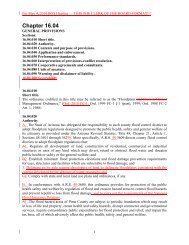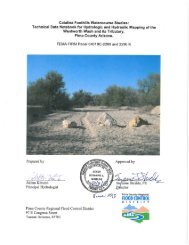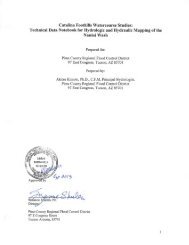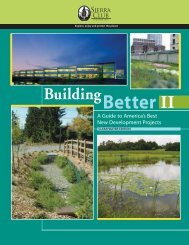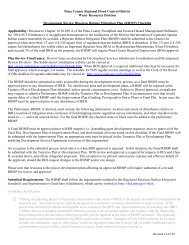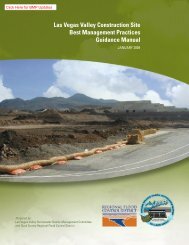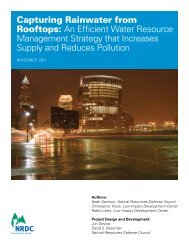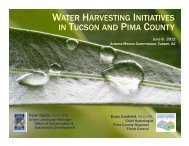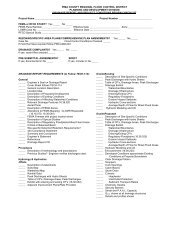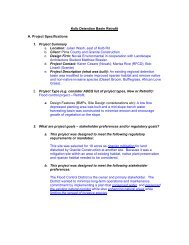Stormwater Manual - Pima County Flood Control District
Stormwater Manual - Pima County Flood Control District
Stormwater Manual - Pima County Flood Control District
Create successful ePaper yourself
Turn your PDF publications into a flip-book with our unique Google optimized e-Paper software.
Pipe bedding shall meet the requirements set forth in the Kentucky Highway Department<br />
Standard Specifications for Road and Bridge Construction, latest edition, and the LFUCG<br />
Standard Drawings, latest edition.<br />
The pipe trench shall be overexcavated six (6) inches and properly backfilled prior to laying<br />
pipe. In no case shall pipe be laid on solid or blasted rock.<br />
Pipe bedding material shall be placed in six (6) inch loose lifts and compacted to 95 percent<br />
maximum dry density at ± 2 percent of the optimum moisture content.<br />
When the subgrade is found to be unstable or to include ashes, cinders, refuse, organic<br />
material, or other unsuitable material, such material shall be removed to the depth ordered by<br />
the Design Engineer and replaced under the directions of the Design Engineer with clean,<br />
stable backfill material. When the bottom of the trench or the subgrade is found to consist of<br />
material that is unstable to such a degree that, in the judgment of the Design Engineer it<br />
cannot be removed, a foundation for the pipe and/or other appurtenance shall be constructed<br />
using piling, timber, concrete, or other materials as the direction of the Design Engineer.<br />
All pipe shall be laid with ends abutting and true to the lines and grades indicated on the<br />
Drawings. The pipe shall be laid straight between changes in alignment and at uniform grade<br />
between changes in grade. Pipe shall be fitted and matched so that when laid to grade, it will<br />
provide a smooth and uniform invert.<br />
The pipe shall be thoroughly cleaned prior to placement. Any piece of pipe or fitting which<br />
is known to be defective shall not be laid. If any defective pipe or fitting shall be discovered<br />
after the pipe is laid, it shall be removed and replaced with a satisfactory pipe or fitting.<br />
The interior of the pipe, as the work progresses, shall be cleaned of dirt, jointing materials,<br />
and superfluous materials of every description. When laying of pipe is stopped for any<br />
reason, the exposed end of such pipe shall be closed with a plug fitted into the pipe bell so as<br />
to exclude earth or other material. Other precautions shall be taken to prevent flotation of<br />
pipe by runoff into trench.<br />
All pipe shall be laid starting at the lowest point and installed so that the spigot ends point in<br />
the direction of flow.<br />
All joint surfaces shall be cleaned immediately before jointing the pipe. The bell or groove<br />
shall be lubricated in accordance with the manufacturer’s recommendation. Each pipe unit<br />
shall then be carefully pushed into place without damage to pipe or gasket. All pipes shall be<br />
provided with home marks to insure proper gasket seating. Details of gasket installation and<br />
joint assembly shall follow the direction of the manufacturer’s of the joint material and of the<br />
pipe. The resulting joints shall be watertight and flexible. No solvent cement joints shall be<br />
allowed.<br />
STORMWATER MANUAL 10-26 January 1, 2009<br />
LEXINGTON-FAYETTE CO., KY.



